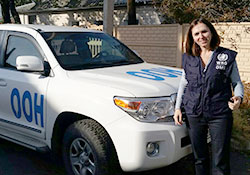Eastern Ukraine: accessing conflict areas to provide assistance is “a major challenge”

WHO/Oleg Storozhenko
Olena Peicheva is a field officer for WHO in Ukraine. Olena was born in Luhansk, a town in eastern Ukraine, and now works 20 kilometres from the frontline of the conflict. A medical doctor, Olena works with WHO partners to provide disease prevention and health care to her fellow citizens. She assists with the delivery of medical supplies through humanitarian convoys, and together with health officials and partners she identifies critical needs in non-government controlled areas (NGCA) of the country. Her main goal, she says, is to help vulnerable people and prevent diseases and outbreaks. Her task is not an easy one.
Five million Ukrainians are affected by the ongoing conflict and more than 1.6 million are displaced, yet humanitarian access remains constrained in conflict areas. “I cannot do my job properly,” says Olena. “To deliver health assistance where it is most needed, I need to access conflict areas, but this is a major challenge.”
Ongoing hostilities and permit restrictions for access to NGCA means that for the populations in these areas, access to essential medicines – such as treatments for cancer, diabetes, kidney failure and tuberculosis, as well as antiretroviral treatment for people living with HIV/AIDS – is extremely limited.
As WHO and relief agencies are unable to deliver supplies to thousands in the most vulnerable groups, preventable diseases are likely to be on the rise. The humanitarian health community is increasingly concerned by this lack of basic health services.
Life-saving interventions can only be implemented if supplies are allowed through and access restrictions are lifted. Olena hopes for a better future: “I remain optimistic and believe that medicine distribution will improve.”



